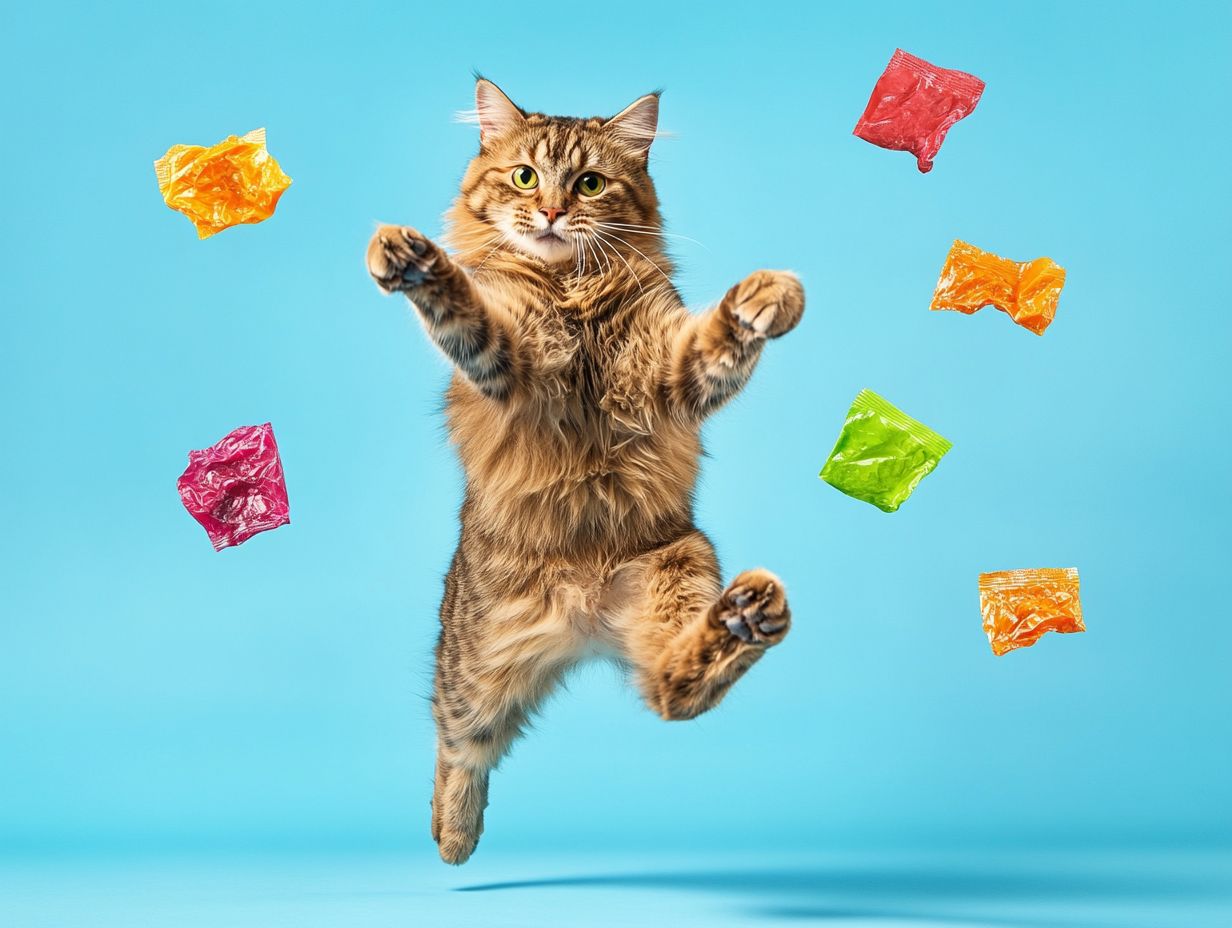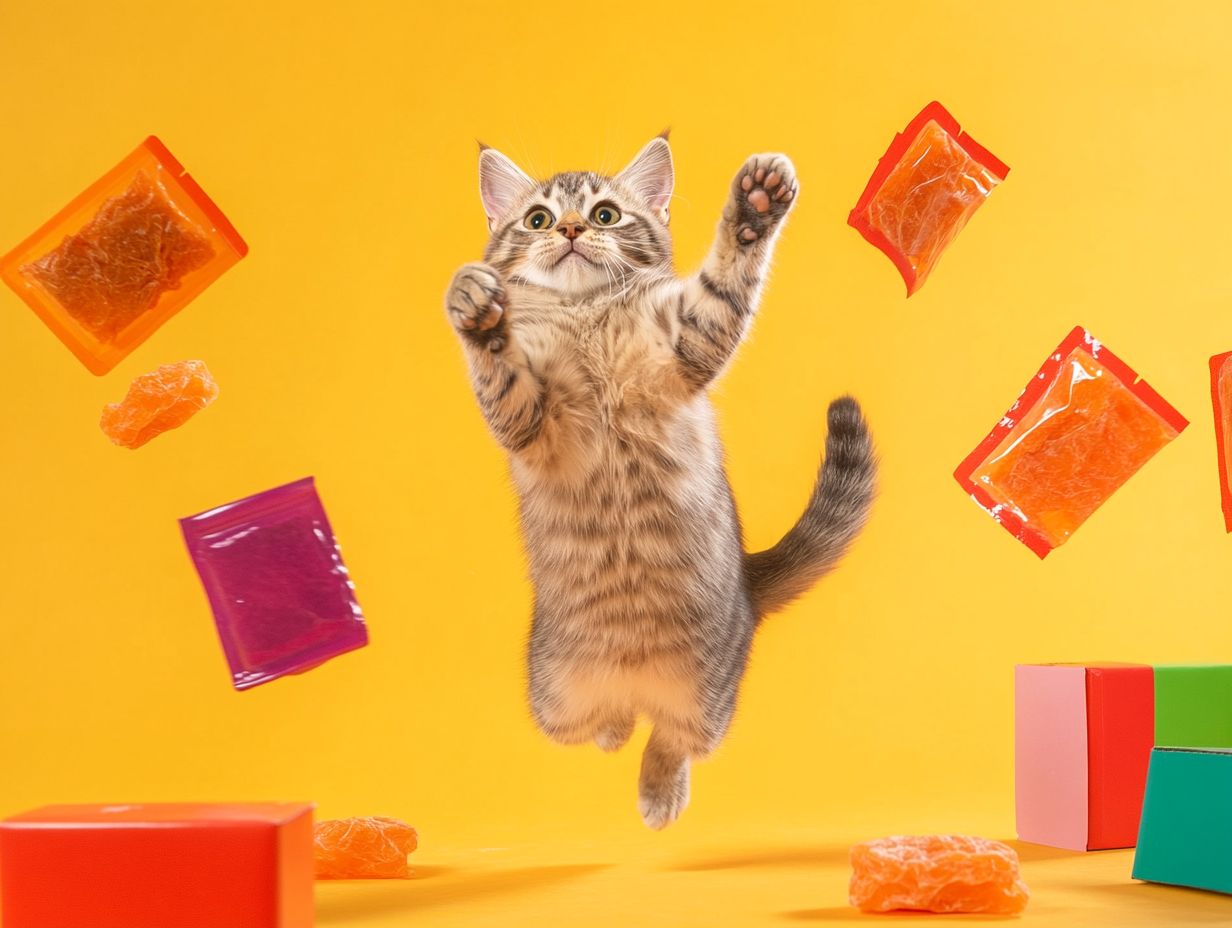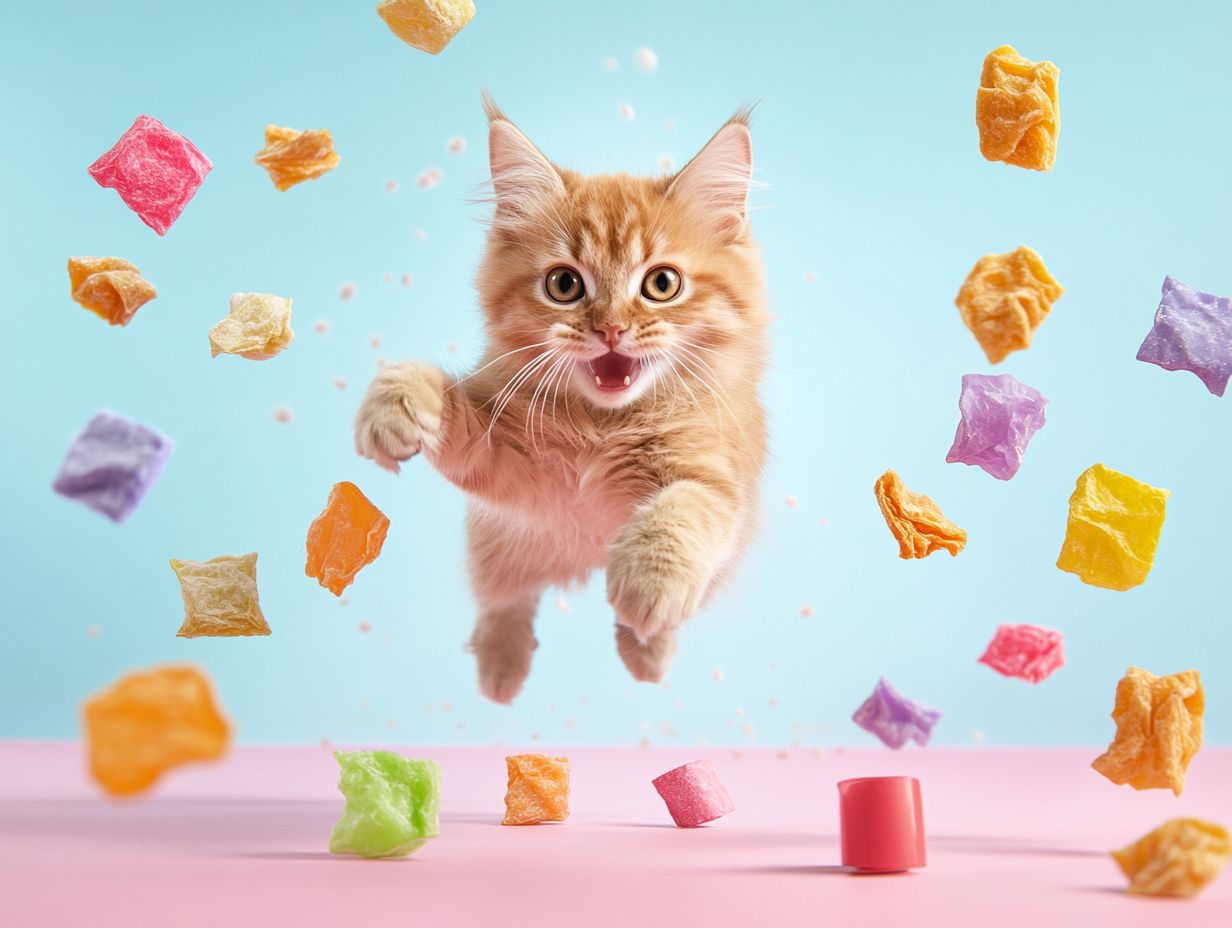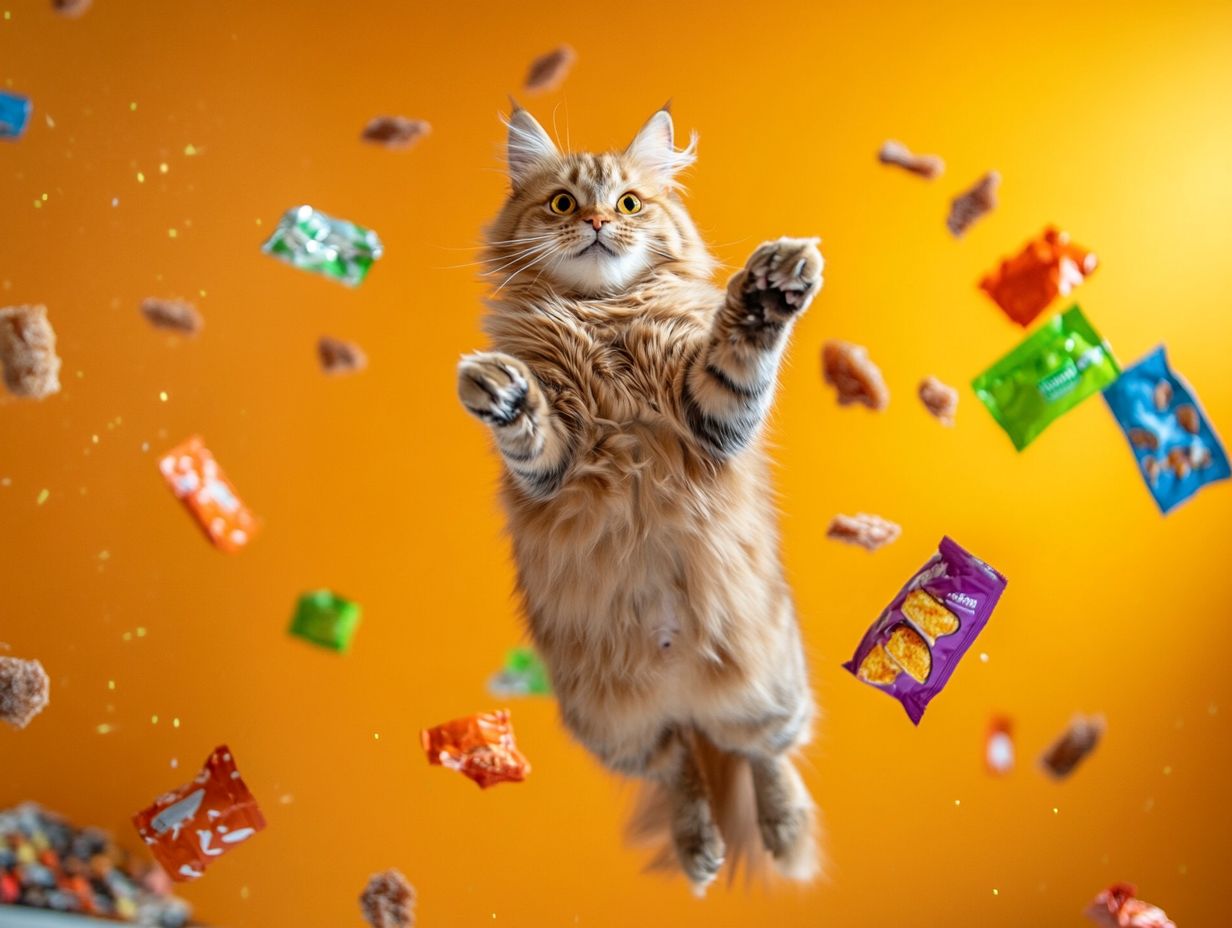Understanding what makes a cat “active” is essential for providing the best care for your energetic feline. This article explores the characteristics that define an active cat, the crucial role nutrition plays in maintaining their energy levels, and how high-quality commercial cat food, with its high-quality ingredients and nutritional benefits, can be beneficial for their diet.
It also highlights popular brands, shares tips for transitioning to new food options, and discusses potential risks, including digestive issues and improper handling of food.
Get ready to elevate your cat’s dining experience!
Key Takeaways:

What Makes a Cat ‘Active’?
An active cat is one that is playful, energetic, and enjoys engaging in physical activities. Activity is a crucial component of overall feline well-being and muscle maintenance. Regular exercise contributes to muscle development and energy levels, allowing cats to express their natural instincts and behaviors. Additionally, staying active helps prevent obesity and related health conditions, ultimately improving a cat’s quality of life.
What Are the Characteristics of an Active Cat?
Active cats exhibit playfulness, curiosity, and a desire for increased engagement through exercise. They participate in a variety of activities, such as chasing toys, exploring their surroundings, and climbing or jumping, all of which demonstrate their strength and playful nature. These activities also help in weight management.
Regular movement in healthy, active cats keeps their minds engaged and is essential for their physical well-being. Since certain conditions, like obesity and arthritis, can restrict a cat’s mobility, maintaining a healthy exercise routine is crucial for achieving an ideal weight and ensuring flexible joints. This allows them to remain active and playful well into their later years.
Why is Nutrition Important for Active Cats?
Nutrition plays a crucial role in the health and performance of active cats, providing them with the essential nutrients needed to sustain their energetic lifestyle and overall well-being. Consulting with a veterinarian is highly recommended to ensure tailored nutrition plans that meet their specific needs.
A balanced diet rich in animal-derived protein sources, vitamins, and minerals is vital for supporting their muscular development, energy levels, and overall health. Proper nutrition, combined with their activity levels, helps in weight management, prevents obesity, and reduces the risk of health issues, including conditions that may arise from inadequate dietary components.
What Nutrients Do Active Cats Need?
The nutritional needs of active cats encompass protein, omega fatty acids, vitamins, and minerals. These macronutrients and micronutrients are essential for maintaining energy levels and overall health. Each nutrient plays a specific role in supporting the health and growth of active cats. Tailored nutrition can address specific needs, such as food sensitivities and digestive health.
For instance, protein is crucial for the construction and repair of all tissues, including muscle. As obligate carnivores, cats require animal-derived protein rather than plant-based sources, making a high-protein diet that includes chicken, beef, and fish ideal for their needs. Organ meat is also an excellent protein source for cats.
Omega fatty acids, often sourced from fish oil, promote joint function, cognitive performance, and the health of the skin and coat. Vitamin B complex, which is water-soluble, plays vital roles in energy metabolism. Additionally, calcium and phosphorus are necessary for structural functions and bone formation.
A well-rounded diet that includes a diverse range of these nutrients is essential for the health of active cats. The Association of American Feed Control Officials (AAFCO) and the World Small Animal Veterinary Association (WSAVA) provide guidelines to ensure these diets meet the necessary nutritional standards.
How Does Diet Affect an Active Cat’s Energy Levels?
Proper dietary choices directly impact an active cat’s energy levels and overall health. It is important to consider allergen safety and potential toxic ingredients in cat food, such as artificial preservatives and certain types of grains. Always read ingredient labels carefully to identify harmful substances and consult with a veterinarian if you have any concerns.
When changing diets, transitional feeding is essential to prevent digestive upset. Gradually introduce new food over a week, mixing it with the old food to ease the transition.
For optimal health, some active cats may also benefit from supplements and additives, but it is crucial to consult veterinary sources for safety, necessity, and recommended dosages.
A cat’s diet plays a crucial role in determining its energy levels, as high-quality animal-source proteins and the appropriate protein content are essential for maintaining an active and energetic lifestyle. As obligate carnivores, cats require protein-rich diets that are primarily sourced from animals to fuel their activities, such as chasing toys and exploring their environments. Formulations that include additional functional nutrients, such as taurine, which supports heart health, and omega-3 fatty acids, known for their benefits to cognitive function, not only help to develop and maintain muscle strength but also contribute to overall health. Grain-free options are available for cats with food sensitivities; however, it’s important to note that some studies have suggested potential links between grain-free diets and heart disease.
Before making any significant changes to your cat’s diet, particularly when considering freeze-dried options or other specialized diets, it is essential to consult with a veterinarian.
Fats are also key components of their diet, serving as a concentrated energy source that supports optimal body weight and stamina during play. Additionally, fiber and moisture in their meals aid in digestion and hydration, further promoting agility and activity.
Considering these various dietary components, it is clear that a well-balanced diet significantly impacts an active cat’s energy levels.
What is Freeze-Dried Cat Food?
Freeze-dried cat food is a type of pet food that retains the nutritional benefits of raw ingredients by removing moisture while preserving essential nutrients. This process ensures that proteins, vitamins, and minerals are maintained in high concentrations.
By eliminating moisture during freeze-drying, high-quality proteins from sources such as meat, fish, and poultry are effectively preserved. Additionally, freeze-dried pet food can be easily rehydrated with water for feeding.
How is Freeze-Dried Cat Food Made?

The production process of freeze-dried cat food begins with the careful selection of raw ingredients that undergo a moisture removal process, ensuring the preservation of essential nutrients. This method utilizes high-quality meats, vegetables, and fruits, which enhance palatability and provide vital vitamins and minerals. Sustainable sourcing of ingredients, including cage-free chicken, is also a priority for many premium brands. However, pet owners should ensure that brands comply with AAFCO nutritional guidelines.
Fresh ingredients are chosen for their purity and freshness to optimize nutritional retention. After selection, the ingredients are rapidly frozen to maintain their natural taste and texture. While the freezing process preserves the food’s moisture content, freeze-drying removes it, resulting in a lightweight product.
This dual-step process safeguards the integrity of the ingredients and assures pet owners that their cats are receiving a balanced, nutrient-dense diet free of fillers.
Why is Freeze-Dried Food a Good Option for Active Cats?
Freeze-dried food is an excellent choice for active cats due to its higher nutritional value, use of quality ingredients, and provision of specific nutrients that support energy expenditure. These features ensure that freeze-dried food supplies active cats with essential protein sources and healthy fats, helping them maintain their energy levels and daily activity.
Additionally, its ease of use allows owners to conveniently control portions and facilitate dietary transitions that promote healthier eating habits. It is vital to monitor portion sizes and consult with a veterinarian regarding specific dietary needs for cats with conditions such as kidney disease or diabetes when considering freeze-dried food.
What Are the Benefits of Freeze-Dried Food for Active Cats?
Freeze-dried food offers several benefits for active cats, including enhanced digestibility, high-quality ingredients, and support for digestive health, making it a preferred choice for many pet owners.
Along with these advantages, freeze-dried food provides balanced nutrition crucial for sustaining an energetic lifestyle. With a carefully formulated blend of proteins, vitamins, and minerals, this diet helps maintain an ideal body weight, ensuring that cats have the energy they need for play and exploration.
The convenience of freeze-dried meals makes them an excellent option for busy pet owners, as they require minimal preparation—simply rehydrate and serve. This ease of use ensures that active felines receive the wholesome nourishment they deserve without any hassle, thereby promoting their overall well-being.
It is recommended to gradually transition to freeze-dried food to avoid digestive upset, and owners should be cautious against feeding solely freeze-dried diets without proper veterinary guidance. Additionally, pet owners should store freeze-dried food in a cool, dry place and regularly check for signs of spoilage, such as unusual smells or changes in texture.
What Are Some Popular Brands of Freeze-Dried Cat Food for Active Cats?
The following premium brands offer freeze-dried cat food designed for active cats, featuring formulations that meet the high nutritional standards and flavor preferences associated with premium products:
- Stella & Chewy’s
- Primal Instinct
- Tiki Cat
- Petcurean Brands (including Go! Solutions, Go! Sensitivity + Shine, and Go! Daily Defence)
- Open Farm
Customer reviews indicate that these brands receive positive feedback for their ingredient quality and nutritional integrity. They provide formulations that support muscle development, energy levels, and overall health in active cats.
1. Stella & Chewy’s Freeze-Dried Raw Dinner Morsels
Stella & Chewy’s Freeze-Dried Raw Dinner Morsels is a highly regarded choice for cat owners seeking freeze-dried cat food that provides specific nutrition for active cats. These morsels feature raw chicken or beef as the primary protein source, essential for muscle development and energy. This product aligns with AAFCO and WSAVA standards and has received positive customer feedback and product reviews for its ingredient quality and health support.
Rich in vitamins, minerals, and omega fatty acids, this food ensures balanced nutrition, meeting all dietary needs to keep felines healthy and active. The freeze-drying process preserves both the nutritional value and flavor, making mealtime enjoyable even for the pickiest eaters.
Incorporating this diet promotes better digestion and overall health. However, it’s crucial to consult with a veterinarian before transitioning your cat to a freeze-dried diet, especially for those with specific health conditions like kidney disease or diabetes.
2. Primal Freeze-Dried Nuggets
Primal Freeze-Dried Nuggets are a protein-rich cat food made with high-quality ingredients like grass-fed beef or free-range chicken, designed to support active lifestyles and overall health. These nuggets ensure that your feline receives essential vitamins and minerals needed for optimal vitality.
Rich in omega fatty acids, they promote a shiny coat and healthy skin. The freeze-drying process preserves the natural flavors and nutrients, making mealtime both enjoyable and nutritious.
Whether your feline friend is a playful kitten or an agile adult, these nuggets cater to their specific dietary needs, promoting strength and endurance for daily adventures. With Primal, you can feel confident that you’re providing a balanced and wholesome meal that keeps your cat thriving.
3. Instinct Freeze-Dried Raw Boost Mixers
Instinct Freeze-Dried Raw Boost Mixers serve as nutritional boosters for a cat’s meals, offering added nutrients and high-quality ingredients specifically designed for active cats. These mixers consist of a blend of freeze-dried raw meat, whole fruits, and vegetables, ensuring that the heightened nutritional needs of more active cats are met while supporting their energy levels and overall vitality.
Formulated specifically for active felines, these mixers help provide essential nutrition and contribute to maintaining healthy skin and a shiny coat. The raw ingredients are minimally processed, preserving important enzymes and nutrients, making them an ideal choice for pet parents who prefer natural feeding options.
Adding Boost Mixers to regular meals is an excellent way to promote the long-term wellness of our furry family members. Always check with a veterinarian regarding any nutritional supplements needed if the diet does not meet all requirements.
4. Orijen Freeze-Dried Cat Treats

Orijen Freeze-Dried Cat Treats are crafted from high-quality ingredients, making them an excellent choice for a delicious snack that fulfills the nutritional needs of active cats. These treats feature a rich blend of free-run chicken, wild-caught fish, and fresh fruits, designed to appeal to even the most discerning feline taste buds.
Available in flavors such as freeze-dried chicken, fish, and turkey, they cater not only to a cat’s palate but also to their nutritional requirements. More than just a tasty indulgence, these treats serve as a rewarding option that encourages playful activity and promotes overall health in cats.
They are an ideal choice for owners seeking a healthy yet enticing reward for their pets. Remember to always check for signs of spoilage, such as off smells or discoloration, to ensure safety.
How Do I Transition My Active Cat to a Freeze-Dried Diet?
Transitioning an active cat to a freeze-dried diet can be straightforward if you adhere to proper meal transition guidelines and consider your cat’s preferences. The key to successfully changing your cat’s diet is to introduce the new food gradually, giving your cat time to adjust to its texture and flavor while allowing you to monitor their reactions. Always consider your cat’s life stage (kitten, adult, senior) and specific health needs to maintain balanced nutrition during the transition.
This approach not only increases acceptance rates but also promotes better digestive health by helping your cat acclimate to the new components of their diet. It’s important to ensure that any changes in diet are supported by current veterinary research or guidelines from authoritative bodies like AAFCO.
What Are Some Tips for Introducing Freeze-Dried Food to an Active Cat?
To successfully introduce freeze-dried food to an active cat while meeting their nutritional needs, consider the following tips. Nutritional needs refer to the specific dietary components required to maintain health, such as proteins, fats, vitamins, and minerals.
Begin by gradually mixing a small amount of freeze-dried food with their current food to help them adjust to the new texture and taste.
Are There Any Risks or Concerns with Feeding Freeze-Dried Food to Active Cats?
The disadvantages of freeze-dried food for cats include potential contamination risks and the possibility of overfeeding. Understanding these concerns is essential for ensuring a safe and healthy diet for your cat, one that will not negatively impact their health and well-being. It is also pertinent to consult with a veterinarian before making any dietary changes.
By addressing these issues, you can help mitigate risks associated with freeze-dried food.
1. Potential for Contamination
The potential for contamination in freeze-dried food can arise from improper handling or poor ingredient quality, posing a risk to the health of active cats. To ensure that our feline friends receive safe and nutritious meals, it is essential to source high-quality ingredients and practice proper handling and storage. Signs of spoilage can include off-odors or changes in texture.
Pet owners should prioritize brands that adhere to strict safety standards and conduct regular testing for contaminants. Additionally, it’s important to store freeze-dried food in a cool, dry place and to keep it sealed to prevent exposure to moisture. Ultimately, taking these precautions not only protects the health of beloved pets but also provides peace of mind for owners, knowing they are offering the best nutrition available.
2. Cost of Freeze-Dried Food
The price of freeze-dried food is significantly higher than that of traditional cat food options, which is a consideration for owners contemplating its use for their active cats. While the cost may be higher, it’s crucial to consider the nutritional benefits and convenience. Freeze-dried brands often contain higher protein levels and superior quality ingredients, appealing to those who prioritize their cats’ nutritional value.
However, it’s worth noting that some freeze-dried food options may lead to nutrient imbalances or inadequate hydration if the cat does not consume enough water. Owners should weigh how much they are willing to invest in their cat’s diet against the potential long-term health benefits offered by more costly freeze-dried options, while also considering ethical and sustainability concerns related to food sourcing.
3. Potential for Overfeeding
Yes, overfeeding can be a potential risk when switching active cats to freeze-dried food due to its high nutrient density. To prevent digestive distress, it is essential to control portions. Nutrient density refers to the amount of nutrients per calorie in the food.
Understanding the unique caloric density of freeze-dried meals is important, as these diets can be significantly richer than standard wet or dry foods. To determine the optimal serving size for an active cat, pet owners should consult the general feeding guidelines provided by manufacturers, which take into account the cat’s weight, age, and activity level. This is particularly important for maintaining a healthy weight, given current feline obesity guidelines.
Monitoring the cat’s body condition and adjusting portion sizes according to their activity can help ensure they receive all necessary nutrients without the adverse effects of overnutrition. A gradual transition to freeze-dried food will also allow the cat’s digestive system to adapt effectively. Discussing any dietary changes with a veterinarian is advisable, especially for those with specific health concerns.
Frequently Asked Questions

What are some benefits of feeding freeze-dried food to active cats?
Freeze-dried food is a great option for high-energy felines because it is packed with nutrients and has a high protein content, helping to support their active lifestyle. It is essential to ensure that these claims are backed by current veterinary research.
Can freeze-dried food provide enough energy for my active cat?
Yes, freeze-dried food is a great source of energy for active cats because it is minimally processed, retains its natural nutrients, and has a high caloric density. However, ensure that the diet remains balanced and consult with a veterinarian if your cat has specific energy needs.
Is freeze-dried food safe for cats with food sensitivities?
Consulting with a veterinarian is crucial for cats with food sensitivities, as they can provide guidance on how freeze-dried food fits into their dietary requirements.
Yes, freeze-dried food is a safe option for cats with food sensitivities because it is made with whole, single-source protein ingredients and does not contain any fillers or artificial additives. However, it’s essential to ensure that the food meets the nutritional standards set by AAFCO. Consult with your veterinarian to confirm that the protein source is appropriate for your cat’s specific sensitivities.
How do I properly store freeze-dried food for my active cat?
It is important to store freeze-dried food in an airtight container or bag to maintain its freshness. It should also be stored in a cool, dry place, ideally between 50°F to 70°F, away from direct sunlight. Additionally, always check the expiration date on the packaging to ensure safety and quality.
How often should I feed my active cat freeze-dried food?
This will depend on your cat’s individual needs, activity level, and life stage (kitten, adult, or senior). Specific health conditions such as obesity or diabetes should also be taken into account. Consult with your veterinarian for their recommendation on feeding frequency for your cat.
Can I mix freeze-dried food with other types of food for my active cat?
Yes, freeze-dried food can be mixed with other types of food, such as wet or raw food, to provide a well-rounded and balanced diet for your active cat. However, it is essential to ensure that all components of the diet are nutritionally complete and balanced. Always consult with a veterinarian before making any changes to your cat’s diet.
Potential Health Concerns
When mixing freeze-dried food with raw options, be aware of the potential risk of bacterial contamination. It’s crucial to practice safe food handling to minimize this risk. Additionally, monitor your cat’s health and weight when introducing freeze-dried food into their diet, ensuring that any changes are gradual and closely observed.